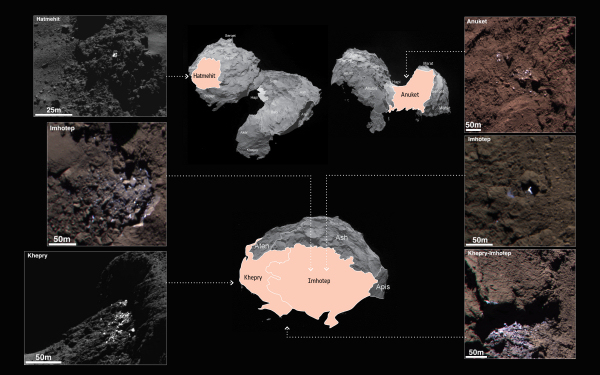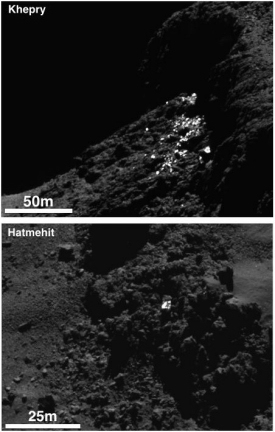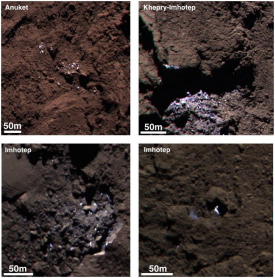Exposed water ice detected on comet's surface
24 June 2015
Using the high-resolution science camera on board ESA's Rosetta spacecraft, scientists have identified more than a hundred patches of water ice a few metres in size on the surface of Comet 67P/Churyumov-Gerasimenko.
 |
| Ice on Comet 67P/Churyumov-Gerasimenko. Credit: ESA/Rosetta/MPS for OSIRIS Team MPS/UPD/LAM/IAA/SSO/INTA/UPM/DASP/IDA |
Rosetta arrived at the comet in August 2014 at a distance of about 100 km and eventually orbited the comet at 10 km or less, allowing high-resolution images of the surface to be acquired.
A new study just published in the journal Astronomy & Astrophysics focuses on an analysis of bright patches of exposed ice on the comet's surface.
Based on observations of the gas emerging from comets, they are known to be rich in ices. As they move closer to the Sun along their orbits, their surfaces are warmed and the ices sublimate into gas, which streams away from the nucleus, dragging along dust particles embedded in the ice to form the coma and tail.
 |
|
Icy clusters and individual boulders. Credit: ESA/Rosetta/MPS for OSIRIS Team MPS/UPD/LAM/IAA/SSO/INTA/UPM/DASP/IDA |
But some of the comet's dust also remains on the surface as the ice below sublimates, or falls back on to the nucleus elsewhere, coating it with a thin layer of dusty material and leaving very little ice directly exposed on the surface. These processes help to explain why Comet 67P/Churyumov-Gerasimenko and other comets seen in previous flyby missions are so dark.
Despite this, Rosetta's suite of instruments has already detected a variety of gases, including water vapour, carbon dioxide and carbon monoxide, thought to originate from frozen reservoirs below the surface.
Now, using images taken with Rosetta's OSIRIS narrow-angle camera last September, scientists have identified 120 regions on the surface of Comet 67P/Churyumov-Gerasimenko that are up to ten times brighter than the average surface brightness.
Some of these bright features are found in clusters, while others appear isolated, and when observed at high resolution, many of them appear to be boulders displaying bright patches on their surfaces.
The clusters of bright features, comprising a few tens of metre-sized boulders spread over several tens of metres, are typically found in debris fields at the base of cliffs. They are most likely the result of recent erosion or collapse of the cliff wall revealing fresher material from below the dust-covered surface.
By contrast, some of the isolated bright objects are found in regions without any apparent relation to the surrounding terrain. These are thought to be objects lifted up from elsewhere on the comet during a period of cometary activity, but with insufficient velocity to escape the gravitational pull of the comet completely.
In all cases, however, the bright patches were found in areas that receive relatively little solar energy, such as in the shadow of a cliff, and no significant changes were observed between images taken over a period of about a month. Furthermore, they were found to be bluer in colour at visible wavelengths compared with the redder background, consistent with an icy component.
 |
| Colour composites of icy bright patches on comet 67P/C-G. Credit: ESA/Rosetta/MPS for OSIRIS Team MPS/UPD/LAM/IAA/SSO/INTA/UPM/DASP/IDA |
"Water ice is the most plausible explanation for the occurrence and properties of these features," says Antoine Pommerol of the University of Bern and lead author of the study.
"At the time of our observations, the comet was far enough from the Sun such that the rate at which water ice would sublimate would have been less than 1 mm per hour of incident solar energy. By contrast, if carbon dioxide or carbon monoxide ice had been exposed, it would have rapidly sublimated when illuminated by the same amount of sunlight. Thus we would not expect to see that type of ice stable on the surface at this time."
The team also turned to laboratory experiments that tested the behaviour of water ice mixed with different minerals under simulated solar illumination in order to gain more insights into the process. They found that after a few hours of sublimation, a dark dust mantle a few millimetres thick was formed. In some places this acted to completely conceal any visible traces of the ice below, but occasionally larger dust grains or chunks would lift from the surface and move elsewhere, exposing bright patches of water ice.
"A 1 mm thick layer of dark dust is sufficient to hide the layers below from optical instruments," confirms Holger Sierks, OSIRIS principal investigator at the Max Planck Institute for Solar System Research in Göttingen.
"The relatively homogeneous dark surface of the nucleus of Comet 67P/Churyumov-Gerasimenko, only punctuated by some metre-scale bright dots, can be explained by the presence of a thin dust mantle composed of refractory mineral and organic matter, with the bright spots corresponding to areas from which the dust mantle was removed, revealing a water-ice-rich subsurface below."
The team also speculates about the timing of the formation of the icy patches. One hypothesis is that they were formed at the time of the last closest approach of the comet to the Sun, 6.5 years ago, with icy blocks ejected into permanently shadowed regions, preserving them for several years below the peak temperature needed for sublimation.
Another idea is that even at relatively large distances from the Sun, carbon dioxide and carbon monoxide driven-activity could eject the icy blocks. In this scenario, it is assumed that the temperature was not yet high enough for water sublimation, such that the water-ice-rich components outlive any exposed carbon dioxide or carbon monoxide ice.
"As the comet continues to approach perihelion, the increase in solar illumination onto the bright patches that were once in shadow should cause changes in their appearance, and we may expect to see new and even larger regions of exposed ice," says Matt Taylor, ESA's Rosetta project scientist.
"Combining OSIRIS observations made pre- and post-perihelion with other instruments will provide valuable insight into what drives the formation and evolution of such regions."
Notes for editors
"OSIRIS observations of metre-size exposures of H2O ice at the surface of 67P/Churyumov-Gerasimenko and interpretation using laboratory experiments" by A. Pommerol et al. is published in Astronomy & Astrophysics
About OSIRIS
The scientific imaging system OSIRIS was built by a consortium led by the Max Planck Institute for Solar System Research (Germany) in collaboration with CISAS, University of Padova (Italy), the Laboratoire d'Astrophysique de Marseille (France), the Instituto de Astrofísica de Andalucia, CSIC (Spain), the Scientific Support Office of the European Space Agency (The Netherlands), the Instituto Nacional de Técnica Aeroespacial (Spain), the Universidad Politéchnica de Madrid (Spain), the Department of Physics and Astronomy of Uppsala University (Sweden), and the Institute of Computer and Network Engineering of the TU Braunschweig (Germany). OSIRIS was financially supported by the national funding agencies of Germany (DLR), France (CNES), Italy (ASI), Spain (MEC), and Sweden (SNSB) and the ESA Technical Directorate.
About Rosetta
Rosetta is an ESA mission with contributions from its Member States and NASA. Rosetta's Philae lander is contributed by a consortium led by DLR, MPS, CNES and ASI.
For further information, please contact:
Antoine Pommerol
University of Bern
Email: Antoine.pommerol![]() space.unibe.ch
space.unibe.ch
Holger Sierks
OSIRIS principal investigator
Max Planck Institute for Solar System Research
Email: sierks![]() mps.mpg.de
mps.mpg.de
Matt Taylor
ESA Rosetta project scientist
Email: matt.taylor![]() esa.int
esa.int



